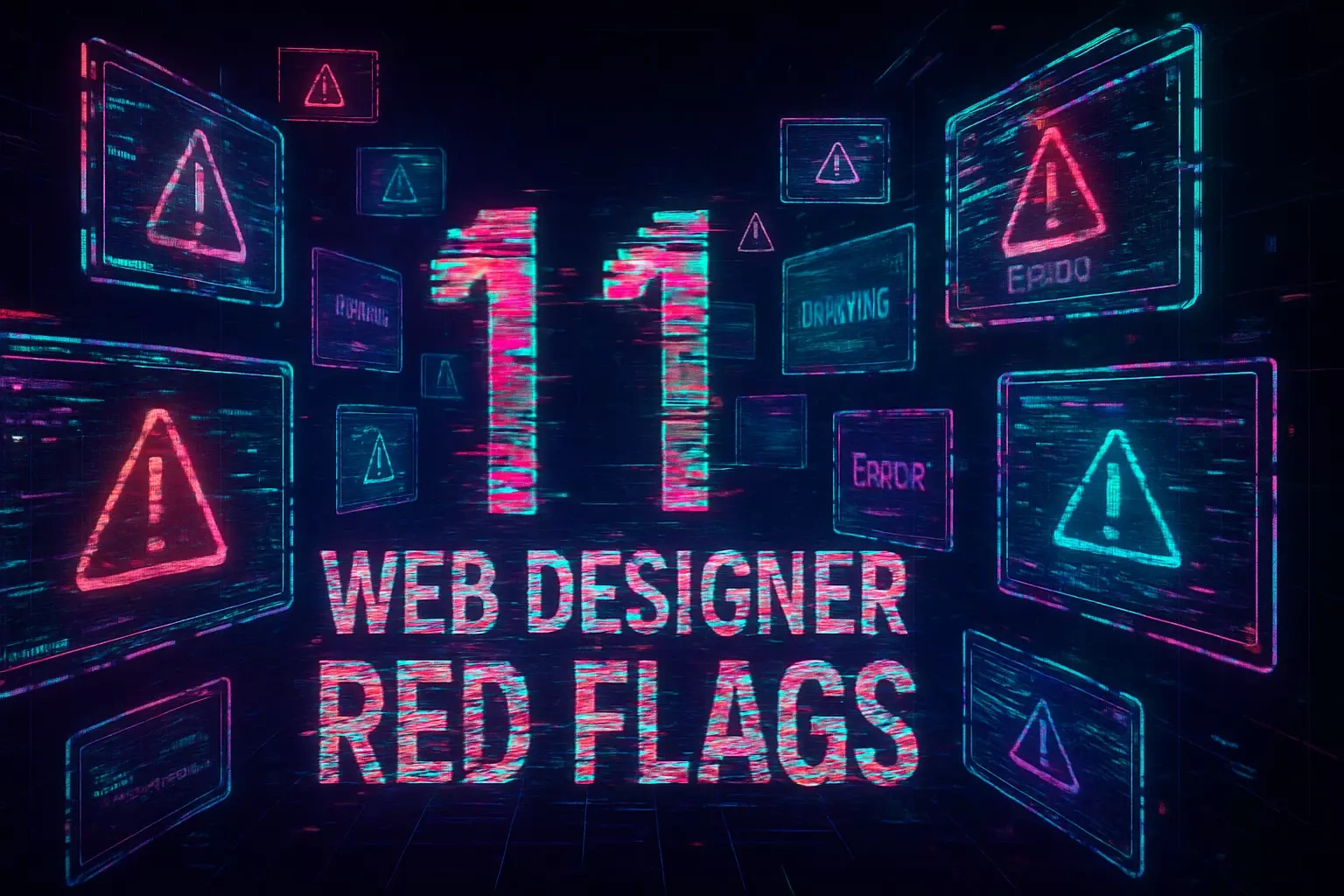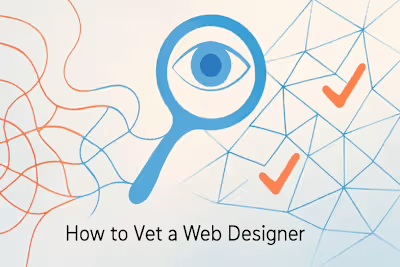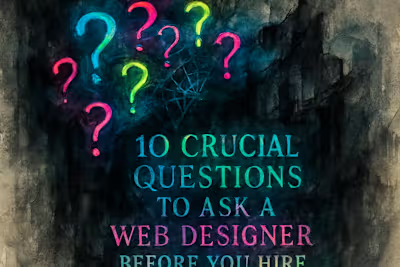11 Web Designer Red Flags: Warning Signs to Watch For Before Hiring

11 Web Designer Red Flags: Warning Signs to Watch For Before Hiring
Red Flags in Their Portfolio and Profile
No Professional Portfolio
Over-reliance on Generic Templates
Promising a Custom Site for an Unusually Low Price
Communication and Professionalism Warning Signs
Poor or Slow Communication
Unwillingness to Sign a Contract
Pressure for Large Upfront Payments
Defensive or Dismissive Attitude
Technical and Skill-Based Red Flags
Inability to Explain Their Design Process
No Mention of SEO or Mobile Responsiveness
Requesting 'Free Samples' or Spec Work
Conclusion
References
11 Web Designer Red Flags: Warning Signs to Watch For Before Hiring
Finding the right web designer can make or break your online presence. A talented designer brings your vision to life and helps your business grow. But hiring the wrong one? That's a recipe for missed deadlines, blown budgets, and endless frustration.
The good news is that problem designers often reveal themselves early. You just need to know what to look for. Before you analyze a portfolio or dive into design samples, watch for these warning signs. Once you spot these red flags, you'll be ready to ask the right interview questions and hire a true professional who delivers results.
Let's explore the most common warning signs that should make you think twice before signing that contract.
Red Flags in Their Portfolio and Profile
Your first interaction with a potential designer tells you a lot. How they present themselves and their work speaks volumes about their professionalism and capabilities. Here's what should raise your eyebrows.
No Professional Portfolio
This one's huge. A web designer without a portfolio is like a chef without a menu. How can you trust someone to build your website if they can't show you what they've built before?
Every legitimate designer has examples of their work ready to share. They should eagerly show you live websites, detailed case studies, or at minimum, comprehensive screenshots of past projects. But here's the catch – they need to prove they actually created these sites.
Watch out for designers who only offer vague screenshots or can't explain their role in the projects they show. Some will grab random website images from the internet and claim credit. Always ask specific questions about their design choices and the challenges they faced. A real designer can talk about their work in detail.
If someone says they're "just starting out" and have no portfolio, that's your cue to move on. Even beginners can create sample projects or redesign existing websites to demonstrate their skills.
Over-reliance on Generic Templates
Templates aren't inherently bad. Many designers use them as starting points. The problem comes when every website in their portfolio looks like it came from the same cookie cutter.
Scroll through their work samples. Do all the sites have the same layout? The same navigation style? The same general feel with just different colors and logos swapped in? That's a bright red flag waving in your face.
This pattern suggests the designer lacks creativity or technical skills to customize designs for different brands. Your business is unique. Your website should be too. A designer who only knows how to tweak templates won't capture what makes your company special.
Good designers might use templates, but they transform them completely. Each site should feel distinct and purposeful, clearly designed for that specific client's needs and audience.
Promising a Custom Site for an Unusually Low Price
We all love a good deal. But when someone promises a fully custom website for $200, alarm bells should ring. Quality web design takes time, skill, and effort. Those things cost money.
Think about it this way. A custom website typically requires:
Initial consultations and strategy sessions
Market and competitor research
Multiple design concepts and revisions
Responsive coding for all devices
Testing and troubleshooting
Launch support and training
Can someone really do all that for pocket change? Not likely.
Ultra-low prices often mean:
You're getting a barely modified template
Hidden fees will pop up for every little change
The designer will rush through or skip important steps
You'll get ghosted halfway through the project
Professional web design typically starts at several thousand dollars for good reason. If the price seems impossibly low, it probably is. You'll either get terrible work or find yourself paying much more through sneaky add-on fees.
Communication and Professionalism Warning Signs
How someone communicates before you hire them shows exactly how they'll communicate during your project. Pay close attention to these interaction red flags.
Poor or Slow Communication
You send an inquiry. Three days pass. Nothing. You follow up. Another two days. Finally, you get a vague one-line response that doesn't answer your questions.
Sound familiar? Run.
Professional designers understand that communication makes or breaks client relationships. They respond within 24-48 hours (excluding weekends). Their messages are clear, thorough, and professional. They ask good questions and provide helpful information.
If someone can't communicate well when they're trying to win your business, imagine how they'll act once they have your deposit. Slow responses turn into missed deadlines. Vague answers become confusion about project requirements. Poor communication skills create project nightmares.
Good designers set expectations upfront. They tell you their typical response time and preferred communication methods. They're proactive about updates and quick to clarify any confusion.
Unwillingness to Sign a Contract
"We don't need all that paperwork. Let's just get started!"
Stop right there. Any designer who avoids contracts is either inexperienced or planning something shady. Contracts protect both of you. They clarify expectations, timelines, payment terms, and what happens if things go wrong.
A professional freelancer always uses contracts. Always. No exceptions. They might have their own standard agreement or be happy to review yours. Either way, they want everything in writing.
Designers who avoid contracts often:
Disappear with your deposit
Claim ownership of your website
Demand extra payment mid-project
Deliver work that doesn't match agreements
Ghost you before completing the project
Never, ever start work without a signed contract. If they resist this basic professional standard, find someone else.
Pressure for Large Upfront Payments
Deposits are normal in web design. Most professionals ask for 25-50% upfront to secure your spot and cover initial work. That's reasonable and expected.
What's not normal? Demands for full payment before any work begins. Or pressure to pay immediately "before prices go up" or to "lock in this special rate."
Scammers love this tactic. They create false urgency, collect your money, then vanish. Or they deliver terrible work knowing you can't get your money back.
Legitimate designers have standard payment terms they apply consistently. They're happy to explain their payment structure and work with you on timing. They never use high-pressure sales tactics or create artificial deadlines.
Watch for payment red flags like:
Demands for payment via untraceable methods
Refusal to provide proper invoices
Sudden "discounts" that expire today
Requests for payment before contract signing
Unwillingness to discuss payment terms
Defensive or Dismissive Attitude
You: "Can you explain why you chose this layout?" Designer: "I'm the expert here. Trust me."
You: "I'd like the logo a bit larger." Designer: "That would ruin the design. You don't understand good aesthetics."
See the problem? Some designers treat clients like annoyances rather than partners. They get defensive about feedback, dismiss your ideas, and act like design gods whose work can't be questioned.
This attitude destroys projects. Web design is collaborative. You know your business and customers. The designer knows design and development. Success comes from combining both perspectives.
Good designers:
Welcome your input and feedback
Explain their choices without condescension
Find creative ways to incorporate your needs
Admit when they don't know something
Treat you as an equal partner
If someone makes you feel stupid for asking questions or wanting changes, move on. The project will only get more frustrating.
Technical and Skill-Based Red Flags
Visual design is just one piece of the web design puzzle. These technical warning signs reveal gaps in essential knowledge.
Inability to Explain Their Design Process
"So how do you approach a new website project?"
"Oh, you know, I just... design it."
That's not a process. That's winging it.
Professional designers follow structured processes that ensure consistent, strategic results. They should easily explain their approach from start to finish. A typical process might include:
Discovery Phase: Learning about your business, goals, and target audience through questionnaires and research.
Strategy Development: Creating site maps, user flows, and content plans based on your objectives.
Design Concepts: Developing initial mockups and getting your feedback before moving forward.
Revisions and Refinement: Incorporating your input through a defined number of revision rounds.
Development: Building the actual website with clean, efficient code.
Testing and Launch: Ensuring everything works perfectly before going live.
Training and Handoff: Teaching you to manage your new site.
If a designer can't articulate their process, they probably don't have one. That means your project will meander without direction, likely missing deadlines and exceeding budgets.
No Mention of SEO or Mobile Responsiveness
Pretty websites that no one can find or use are worthless. Yet some designers still focus purely on aesthetics while ignoring functionality.
During initial conversations, professional designers should bring up:
SEO Basics: How they'll structure your site for search engines. This includes proper heading tags, meta descriptions, clean URLs, and fast loading speeds. They don't need to be SEO experts, but they should understand the fundamentals.
Mobile-First Design: Over 60% of web traffic comes from mobile devices. Your designer should talk about responsive design, mobile user experience, and testing across different devices and screen sizes.
Performance Optimization: Beautiful designs mean nothing if your site takes forever to load. Good designers consider image optimization, code efficiency, and hosting requirements.
If a designer never mentions these crucial elements, they're living in 2005. Modern web design balances beauty with functionality. One without the other fails.
Requesting 'Free Samples' or Spec Work
"Before we move forward, could you mock up our homepage so we can see if we like your style?"
This request seems reasonable on the surface. You want to see their capabilities, right? Wrong. This is often a scam to get free work.
Professional designers prove their abilities through their portfolio. That's what portfolios are for. Asking for custom work before hiring is like asking a restaurant to cook you a free meal to see if you like their food.
Why spec work is a red flag:
Scammers collect "samples" from multiple designers and use them without paying
It shows disrespect for the designer's time and expertise
Legitimate clients understand portfolios demonstrate capability
It often indicates the "client" has no budget or intention to hire
Some variations of this scam include "design contests" where multiple designers create full concepts but only one gets paid, or "trial projects" at drastically reduced rates.
Real professionals politely decline spec work. They might offer to show more portfolio pieces or discuss their process in detail, but they won't work for free.
Conclusion
Hiring a web designer shouldn't feel like navigating a minefield. Now that you know these 11 red flags, you're equipped to spot problems before they cost you time and money.
Remember, good designers want you to succeed. They communicate clearly, respect your input, and follow professional standards. They're proud to show their work, explain their process, and put agreements in writing.
Trust your instincts. If something feels off during initial conversations, it probably is. Don't let excitement about your new website blind you to obvious warning signs.
Take your time finding the right designer. Ask questions. Check references. Review contracts carefully. The extra effort upfront saves massive headaches later.
Your website represents your business online. It deserves a designer who brings professionalism, skill, and integrity to the project. Now you know exactly what to avoid – and what to look for – in your search for the perfect web design partner.
References
Like this project
Posted Jun 30, 2025
Hiring the wrong web designer can cost you time, money, and stress. Learn to spot the most common red flags in portfolios, communication, and professionalism.











